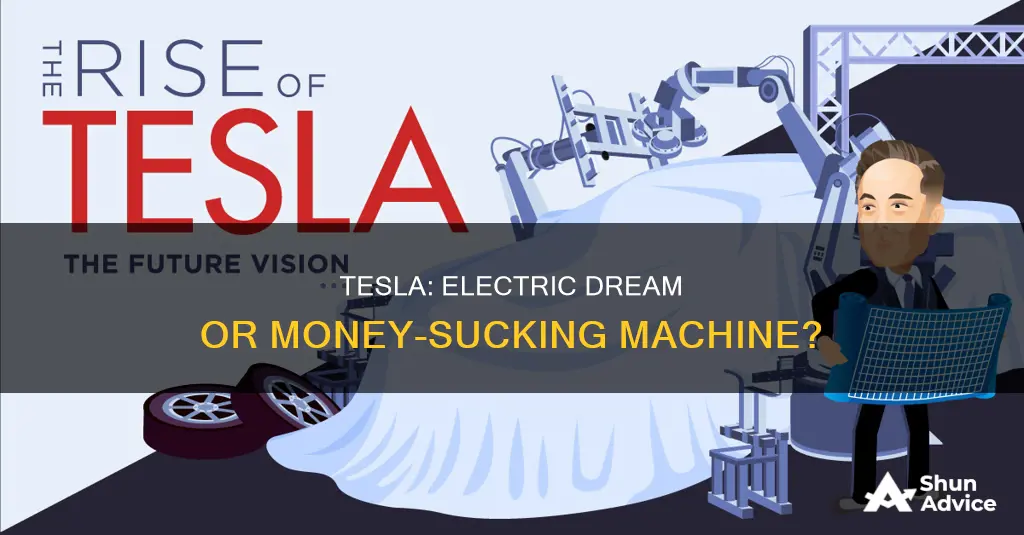
Is buying a Tesla a bad investment? Well, it depends. Teslas are impressive cars, but like all vehicles, they come with drawbacks. Here are some of the most important reasons why buying a Tesla may not be a good investment for you.
Firstly, the cost of a Tesla is anything but affordable. With starting prices ranging from $42,000 to over $50,000 for the 2024 models, not including taxes and interest on loans, they are far from cheap. This high sticker price makes it difficult to keep money in your bank account.
Secondly, there are added costs to consider. For example, choosing a model with a long-range battery or enhanced features like Autopilot will cost you extra. Supercharging your Tesla at public stations is also not free and can be quite expensive. Additionally, you may need to purchase home-charging equipment, which can cost anywhere from $35 to $595.
Thirdly, Tesla vehicles might be hard to maintain. Finding a professional with experience in servicing Teslas can be challenging and lead to higher costs. The wait time for parts to come in can also be long, leaving you without a car for an extended period.
Another thing to consider is the build quality. Over the years, there have been complaints about paint flaking easily, body panels not lining up properly, and interior fittings not being solidly made. Some customers have also experienced issues with charging ports, keyless entry systems, and touchscreen overheating.
Finally, you should be aware that you will likely have to pay a premium for car insurance on a Tesla. The cars can be more expensive to repair and replace, resulting in higher insurance costs.
So, before you rush out to buy a Tesla, carefully consider your financial situation and whether the benefits outweigh the potential drawbacks.
| Characteristics | Values |
|---|---|
| Cost | The cost of a Tesla varies depending on the model, with the Model 3 Long Range being the most affordable option with a starting purchase price of $46,990. The price of a Tesla can also vary due to fluctuations in the market, with some buyers experiencing significant price drops after purchasing their vehicle. |
| Charging | Charging a Tesla at home is convenient but not realistic for everyone. Superchargers in public areas are the fastest way to charge but come at an additional cost. |
| Maintenance | Tesla vehicles may not always be easy to maintain due to the need for experienced professionals who are familiar with the unique features of the car. |
| Safety | Tesla vehicles have advanced safety features, such as automatic emergency braking and Autopilot self-driving capabilities, which require a subscription or one-off payment. |
| Customer Service | Some users have reported negative experiences with Tesla's customer service, particularly after the warranty period has expired. |
| Build Quality | There have been complaints about the build quality of Tesla vehicles, including issues with paint, body panels, interior fittings, and windshields. |
| Waiting Period | There may be a waiting period of several months before receiving a Tesla due to manufacturing and supply chain issues. |
| Tax Rebates | Tesla owners may be eligible for tax rebates or incentives for purchasing an electric vehicle, but there are certain requirements and price caps that must be met. |
| Competition | There are alternative options in the market, including cheaper and more efficient models from other manufacturers. |
What You'll Learn

Tesla's high price tag and depreciation
Teslas High Price Tag and Depreciation
The Price Tag
The cost of a Tesla is anything but affordable. A 2024 Tesla Model 3 is expected to start at around $42,000, while the Tesla Model Y AWD will start at more than $50,000. On top of that, you'll also have to pay taxes and, if you take out a loan for the car, you'll be paying interest charges too.
Depreciation
Despite their high price tag, Teslas are good at holding their value. According to CarEdge, Tesla ranks in the top 3 of luxury brands, with owners able to expect a depreciation of around 3% in the first year, 12% in the second, 20% in the third, 28% in the fourth, and 32% in the fifth—ending up at around 50% after ten years. This is because electric car technology changes more quickly than iPhone apps, so older models become outdated faster.
However, some people have pointed out that the high price tag and rapid depreciation mean that you could lose a lot of money very quickly. For example, one person who bought a Tesla in 2022 said that it had lost 50% of its value in just two weeks.
The Positives
Despite the high price tag and depreciation, there are some positives to buying a Tesla. Firstly, compared to regular gas-powered vehicles, Teslas depreciate at a slower rate. This is because most Teslas will last over 500,000 miles, while the average person only drives 13,500 miles a year. Therefore, their depreciation is not typically evaluated based on mileage but on their remaining battery capacity.
Another reason why Teslas hold their value is that the company continues to improve its existing products through updates, boosting their used-car value and resale prices. For example, Tesla is currently working on its Full Self Driving (FSD) capability, which is expected to increase the resale value of its cars.
Additionally, Tesla's warranties also help to protect your investment by covering costly components such as the battery and drive unit. The company offers a minimum eight-year or 100,000-mile warranty on these parts, with a minimum 70% retention of battery capacity over the warranty period.
The Bottom Line
While Teslas have a high price tag and depreciate quickly, they also hold their value well compared to other cars, especially internal combustion engine (ICE) cars. This is due to slower depreciation, steady improvements, demand, and warranty protection. Therefore, while buying a Tesla may not be a good investment for everyone, it is not necessarily a bad one either.
Retirement Accounts: The Illusion of a Secure Future
You may want to see also

Poor build quality and customer service
Tesla's poor build quality and customer service have been a cause for concern for many customers. There have been numerous complaints about the paint being too thin and flaking easily, body panels not lining up properly, and interior fittings not being solidly made. Some customers have also experienced major malfunctions with their vehicles, which have taken a long time to get sorted out.
One common issue with Teslas is the suspension and steering. Tens of thousands of Tesla owners have experienced premature failures of suspension or steering parts, with records and interviews revealing that the company has long known more about the frequency and extent of these defects than they have disclosed to consumers and safety regulators. In some cases, Tesla has blamed drivers for these failures, citing "vehicle misuse" or "driver abuse". This has left many customers feeling frustrated and dismayed, especially those who have had to pay for costly repairs out of pocket.
The company's customer service has also been criticised for being unresponsive and unhelpful. Many customers have complained about long wait times for repairs, last-minute cancellations, a lack of loaner cars, and generally unpleasant customer service experiences. In some cases, customers have had to wait weeks or even months for a response from Tesla, and those who have managed to get through have reported being treated rudely or dismissively. This has led to a sense of being "ghosted" or "left in limbo" by the company.
The issues with build quality and customer service are not limited to Tesla's cars but also extend to their solar power division and SpaceX's Starlink satellite internet service. Customers of these services have reported similar problems with opaque delivery timing, difficulty reaching customer service representatives, and long wait times for repairs or responses.
Overall, while some owners are satisfied with the level of service they receive, the general consensus is that Tesla's build quality and customer service are poor and in need of significant improvement. The company's focus on aggressive growth and new products seems to have taken precedence over addressing these issues, and this may come back to bite them as more customers become frustrated and disillusioned with the brand.
Broaden Your Horizons: Diversifying Retirement Investments Across Nine Key Areas
You may want to see also

Long waiting times
There are several factors contributing to these long waiting times. Firstly, demand for Teslas is high, driven by consumers' desire to avoid high gas prices and reduce their carbon footprint. Tesla's popularity is also a factor, with the Model Y being the best-selling EV on the market, accounting for a third of all EVs sold in 2022.
Another factor is Tesla's production capacity. The company has previously struggled to keep up with demand due to issues with inflation and supply chain disruptions. However, it is worth noting that wait times for Teslas are comparable to those of other popular EVs, such as the Porsche Taycan, Volkswagen ID.4, and Ford Mustang Mach-E, which also have estimated waiting times of over six months.
The length of the wait also depends on the chosen configuration and add-ons. In some cases, adding premium extras can improve delivery estimates, but this is not always the case. For example, the standard Tesla Model S has a delivery estimate of June 2024, and adding extras like premium paint jobs or enhanced Autopilot does not visibly improve this estimate.
To reduce the wait, some consumers may consider buying a used Tesla. The used car market for Teslas is currently strong, with high demand driving up prices. However, this option comes with its own set of drawbacks, as used cars may have higher mileage, require repairs, or lack the latest advances and tweaks made by Tesla in recent years.
Overall, long waiting times continue to be a challenge for those looking to purchase a Tesla, but this issue is not unique to the brand, and comparable wait times can be expected for other popular EV models.
Will Quinn's Investment Cabins: A Cozy Bet on Comfort and Returns
You may want to see also

Inability to charge at home
Owning a Tesla without being able to charge it at home can be a significant inconvenience. Not being able to charge your vehicle at home may mean having to plan your trips around charging stations, which can be time-consuming and frustrating.
Charging a Tesla at home requires the installation of specific equipment, such as a Wall Connector or a Universal Wall Connector. These connectors are Wi-fi enabled and can be purchased from Tesla, with prices ranging from $35 to $595. However, the initial cost of the equipment is not the only expense to consider. Depending on your situation, you may also need to factor in the cost of a new transformer and the installation of proper wiring, which can be a significant investment.
In some cases, homeowners may face additional challenges or restrictions when attempting to install charging equipment. For example, those living in condominiums or homes with a Homeowners Association (HOA) may need to obtain approval for installing a charging station. Additionally, there may be concerns about overloading circuits or increasing fire hazards, as seen in the case of one new Tesla owner, who was prohibited from charging their vehicle in their garage by the HOA.
While Superchargers are a viable alternative, they come with their own set of drawbacks. Supercharging a Tesla can be significantly more expensive than charging at home, with costs reaching up to $0.60 per kWh in California. Moreover, Superchargers may not always be conveniently located, and you may have to compete with other Tesla owners for access to charging stations.
Therefore, the inability to charge a Tesla at home can be a significant disadvantage and may deter potential buyers. The added costs and inconveniences associated with public charging stations can make owning a Tesla a less attractive option, especially for those who do not have easy access to home charging facilities.
The Great Debate: Paying Off Your Home vs. Investing — Which Should You Choose?
You may want to see also

Cost of insurance and repairs
The cost of insuring a Tesla varies depending on the model, the driver's age, driving history, and location. On average, the Tesla Model 3 is the cheapest to insure at $1,712 per year, while the Model Y is the most expensive at $2,878 per year. The high cost of insuring a Tesla is due to the high repair costs associated with the vehicles. Teslas are expensive to repair because they are made with costly parts and require repairs to be done by Tesla-approved body shops.
Tesla also offers its own insurance, which claims to be 20-30% cheaper than competitors. However, Tesla insurance is currently only available in 12 states and has received numerous complaints regarding poor customer service.
When considering the cost of insurance and repairs, it is important to keep in mind that Teslas are generally more expensive to maintain than other vehicles. The high cost of insurance and repairs is something potential Tesla buyers should carefully consider before purchasing. While Teslas offer a stylish look and impressive features, the ongoing maintenance costs may outweigh the benefits for some individuals.
In addition to the cost of insurance and repairs, there are other financial considerations to keep in mind when purchasing a Tesla. The vehicles themselves are priced similarly to luxury cars and other electric vehicles, with a starting price of around $38,990 to over $110,000, depending on the model and trim. Upgrades such as self-driving capabilities and custom paint colors can further increase the price.
Overall, while Teslas may be tempting due to their sleek design and advanced features, potential buyers should carefully weigh the financial implications, including the cost of insurance and repairs, before making a purchase.
The Boomer Retirement Crisis: Navigating the Investment Maze
You may want to see also







